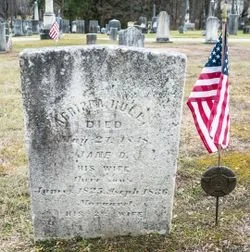Agrippa Hull: The Sage of Stockbridge
When he died in 1848, Agrippa Hull was Stockbridge, Massachusetts's last surviving veteran of the American Revolutionary War. He had become the role model adults in the village pointed out to their youth, a model citizen and village sage, admired for his courtesy, work ethic, modest prosperity, good moral character, and Christian faith.
"If thou are young," a local newspaper advised, "imitate this man's example, and you will live many years upon the earth and rejoice in them all."
When Francis Parkman, in 1844 the nation's best known historian, came to visit Stockbridge, Hull (who had no grandchildren of his own) told him "These are my children," stretching his cane over several young boys playing. "Ah, how we are consarned to fetch them up well and virtuous."
The grandson of General John Patterson wrote half a century later, "As long as he lived the children and the grandchildren of the officers he had known went frequently to Stockbridge to see him...He would hold the little children on his knees, while the older ones gathered round him. As he grew old, he lived the war over and over again with the children, and would patiently repeat story after story."
Hull served longer than most: 74 months in the Continental Army. Many soldiers served a year or two, perhaps three, or rotated in and out for some months, going home after a major battle. Only 16 when fighting broke out in 1775, he enlisted May 1, 1777 in Isaac Marsh's First Stockbridge Company for a term of three years, or the duration of the war. The muster roll describes him as "Stature, 5 ft., 7 in.; complexion, black; hair, wool." The company moved north to join the series of battles that culminated in the American victory at Saratoga later that year.
Hull spent most of the war assigned as an orderly, first for two years to General Patterson, later to Colonel Tadeusz Kosciuszko (pictured at right).
That is a military assignment, not one as either a hired or bond servant. It often involves danger and participation in battle, but it is first and foremost, one of personal service to a senior officer.
Hull's complexion may have been a consideration. So may the fact that he did not own a firearm and therefore did not bring a weapon when he enlisted.
Hull spent the winter of 1777-1778 at Valley Forge, stood by Patterson through fighting around Philadelphia, and at the Battle of Monmouth, and then to the fortification at West Point, which Kosciuszko had been fortifying. Hull became acquainted with John Laurens, the South Carolinian who advocated enlistment of Africa Americans, and Lafayette, the French officer assigned to Washington's staff. He was reassigned at West Point to Kosciuszko, who was intent on joining the epic battles in the southern states against British Generals Cornwallis and Tarleton.
During 50 months with Kosciuszko, Hull experienced some of the most intense fighting of the war. Some of Hull's most vivid memories were formed in the fighting at Eutaw Springs, South Carolina, where he worked with the medical staff on 375 badly wounded soldiers. (The British army took 40 percent casualties.)
There are few written records of Hull's service and assignments, but Patterson's descendants recalled heaing that he "was intelligent and unusually bright" and "his aptness and wit and his readiness in repartee, as well as the intelligent manner in which he performed all his duties, made him a great favorite with all the officers of the army stationed at 'the Point'."
Agrippa Hull’s home, now being restored by the Bidwell House Museum.
In 1784, Hull purchased his first piece of land for nine pounds -- possibly paid for by redeeming the back pay certificates for his military service. He purchased two more parcels, 1789-1790, The deeds describe him as a "Negro man and laborer" and a "yeoman." He purchased three more parcels between 1789 and 1792, acquiring a total of 11 acres. For the rest of his life, local tax assessments show him as wealthiest among 14 families of African descent, and ahead of 64 of Stockbridge's "white" families.
Agrippa Hull died in 1848, 65 years after the final victory of American independence.
He was survived by his second wife, Margaret, who died in 1870, five years after the Civil War.
More details of Hull’s life can be found at https://www.bidwellhousemuseum.org/blog/2023/02/14/bidwell-lore-introducing-agrippa-hull/





